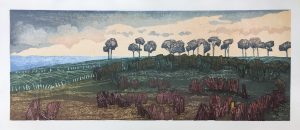You might have noticed there was no Friday blog last week. Writing came a poor second to printmaking that week and a good deal of the week before, as did laundry, regular meals, exercise and remembering not to hold my breath for long periods. I’m sure you’ll recognise the symptoms of starting a new project and the excitement of running with your ideas to the exclusion of everything else.
For most of my life the failure to provide a Friday blog as promised would be so anxiety inducing that I’d have made myself write one whatever the inconvenience. Letting people down, however distant and virtual those people might be and however tenuous the promise, is a fear I have in common with many others and it’s one that’s easing gradually. I’m sure I’m not the only person to back themselves into a corner by making a commitment while failing to realise that it’s mainly, or even only, me that actually cares about it. I’m guessing you’re OK with this blog missing the odd week or two*. It’s not a huge deal, I’m not writing anything more important than something to muse over while eating a biscuit. I’m getting over it and, if you’re prone to worrying about this kind of thing like me, have another biscuit and drop a few minor commitments too.
The all-consuming project is far more exciting. I am making a set of Japanese woodblock prints of the North Yorkshire Moors.

These prints have demanded a fresh approach and I’ve been rising to the challenge. Ironically these new Japanese woodblock prints owe much to the kind of mark making that’s more a part of traditional linocut, while my recent lino work is fast becoming indistinguishable from the washy transparency of traditional Japanese woodblocks. Contrary, but it’s what’s working for me and now it’s working, I can’t leave the printmaking alone. So this week’s blog was a bit touch and go too if I’m honest.
This week on the Ask an Artist podcast we interview master paint maker Michael Harding who, even as a student, never had any issues about prioritising his love of mixing pigments to the exclusion of everything else, including the welfare of his bedsit and the loss of his housing deposit.
*I did get one complaint from my brother-in-law who wanted last week’s blog to feature my award for the tartan todger. Sorry about that, but the whole story of my early artistic genius concerning the male member is included in last week’s Ask an Artist episode on competitions.